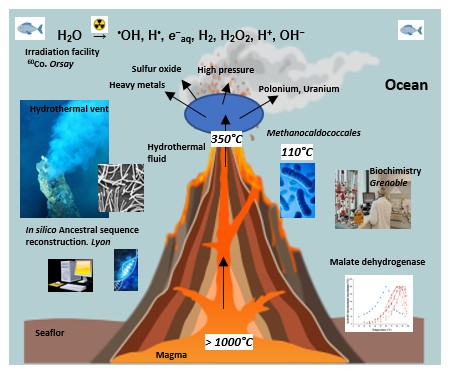Enzymes are responsible for the chemical reactions that provide energy and transform various constituents during cellular metabolism. How they acquired their specific functions during evolution is a fundamental question. Indeed, the way they function today has evolved over very long periods of time. As part of a collaborative project, researchers at Irig/IBS have characterized very ancient enzymes, from extremophiles (micro-organisms capable of living in extreme conditions of temperature, pressure, etc.), using a paleo-enzymological approach to understand how some of today's enzymes have evolved.
Some micro-organisms, such as methanogenic archaea (unicellular prokaryotic micro-organisms that produce methane), have colonized a wide range of environments with very different temperature conditions. For example, growth temperatures approach 100°C for species isolated in deep hydrothermal vents. Their enzymes are therefore adapted to operate in these conditions.
Using malate dehydrogenase, an enzyme involved in metabolism, and using an evolutionary biochemistry approach coupled to a previously described biophysical approach, it has been possible to identify mutations responsible for the adaptation to various modern enzyme lineages from an ancestral form capable of withstanding conditions of radioactivity and temperature considered extremely deleterious. Until now, the ability to resist radioactivity had only been shown for some cells, in particular via DNA protection/repair mechanisms.
For the first time, researchers at Irig/IBS have demonstrated the existence of a favorable capacity to resist a strong radioactive dose, which seems to be quite ancient.

 Ancient methanogenic Archaea living in hot and/or radioactive environment
Ancient methanogenic Archaea living in hot and/or radioactive environment
(D. Mardern / IBS)
The discovery of a link between the thermal stability of an enzyme and its ability to survive intense radioactive stress opens up new prospects for studying the conditions of emergence of ancient cells under radioactive environmental conditions previously prevalent on Earth or found on other planets. This study also contributes to a better understanding of the process of rational engineering of enzymes useful for cleaning up radioactive sites.
Additional information
The resurrection of ancient proteins is based on a bioinformatic method for reconstructing ancestral sequences. The calculated coding sequences are then fully chemically synthesized. The genes thus obtained are introduced into bacteria, which then “manufacture” the corresponding proteins. These proteins are then characterized in the laboratory using a variety of techniques.
Collaborations
- LBBE, Laboratoire de Biométrie et Biologie Evolutive, Lyon
- ICP, Institut de Physico Chimie, Orsay
Fundings
ANR Allospace & Thermadapt projects